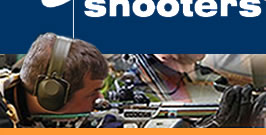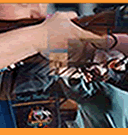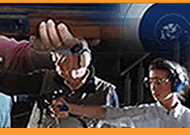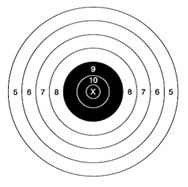








![]()
What is the Australian Target Shooters Club?
What is target shooting?
Are Australians recognized as world-class competitors in the sport of shooting?
How safe is the sport of target shooting?
What's the legal status of target shooting?
What are safety aspects that have been taken to ensure a safe environment?
Who can join the ATSC?
So, how do I become a member of ATSC?
What are the benefits of becoming a member?
How much does it cost to become a member of ATSC?
Will I need a firearm licence?
How much does Firearm Safety Training cost?
Will I need to purchase a firearm to join?
What sort of firearms does ATSC use?
What sort of targets does ATSC use?
Can I store my firearm with ATSC?
I've never handled a firearm before in my life - does that matter?
Are the members that train me experienced instructors?
Is target shooting popular in other countries?
What are the contact details for the ATSC?
What is the Australian Target Shooters Club?
The Australian Target Shooters Club (ATSC) is the unique new way to give interested people the opportunity to try the different disciplines of the sport of target shooting in a responsible, safe and legal environment.
The ATSC enables people interested in the idea of target shooting to try the sport using club firearms under the supervision and tuition of trained club members. This means that the person involved does not have to purchase their own firearm and provide the secure storage required by law, until they have decided which type of target shooting they prefer.
The ATSC is a multi-discipline target shooters’ club that will provide training and competition for members in rifle, shotgun and pistol disciplines.
The ATSC has reciprocal rights with over 300 target shooting clubs in NSW that will enable members in all areas to visit those clubs for a wider experience in competition.
What is target shooting?
Target shooting has been a popular pastime and sport in Australia for many years and produced sportsmen and women who have competed in the various target shooting disciplines at the elite levels of the Commonwealth and Olympic Games and other international competitions.
It is a skilful, challenging sport and the different disciplines include trap or clay target, pistol, small bore and fullbore rifle, air rifle and air pistol.
All of these are international sporting shooting disciplines and many are Olympic and/or Commonwealth Games events in which Australian team members have been medal winners over many years.
The sport appeals to all ages, and people from a wide and diverse background. It can also be described as a sport that, even at the highest level, does not require the elite standard of physical fitness demanded by some other sports.
Target shooting is exactly what it says. Participants shoot at various types of targets according to the shooting discipline. The targets range from circular clay discs moving rapidly through the air in clay target shooting to paper targets placed at distances from 10, 25, 50 to 300 metres in air rifle, pistol and small bore, and up to 1,000 metres in full bore shooting.
Are Australians recognized as world-class competitors in the sport of shooting?
A national Australian rifle team first competed in a shooting competition at Wimbledon in 1876, well before any national teams of Australian tennis players, cricketers or footballers.
Shooting is a sport in which many Australians have achieved national and international success. At the 2004 Athens Olympics Suzie Balogh from NSW won the Gold Medal in Trap Shooting and Michael Vella from Victoria won Bronze.
In Manchester in 2002, Australian target shooters won 31 of the 207 total medals won by Australia, exceeded only by Swimming with 50 medals and ahead of Athletics with 28. Training is now well under way for prospective members of the Australian Commonwealth Games Team 2006 Games in Melbourne next March.
A medal tally of over 50 is realistically anticipated for the Australian shooting team at the 2006 Commonwealth Games being held in Melbourne next March
How safe is the sport of target shooting?
It comes as a surprise to many people when they learn that target shooting is one of the safest sports of all.
The NSW Shooting Association, peak body for shooting in NSW, is a member of the NSW Sporting Injuries Insurance Scheme, which was established in 1978. There has never been a claim for any injury in the sport of target shooting in NSW in the history of the scheme. By contrast, over $12 million dollars in claims have been made since the inception of the scheme. Since 1996 more than $1.5 million in claims have been made each year for injuries sustained in other sports.
In the “NSW Sports Shooting Injuries Report” Aug 2000 the authors found that “competitive sports shooting is a remarkably safe sport compared to sports generally and that competition sports shooting is significantly safer than the general use of firearms.” Only one minor injury was reported in this study and that was caused by a flagstaff hitting a competitor on the nose. It was not caused by a firearm.
The ATSC is a responsible member of the sporting community and is committed to providing and promoting a safe environment for the sport of shooting together with the safe, responsible participation of its members.
What's the legal status of target shooting?
Target shooting is a legal, competitive sport that is enjoyed by hundreds of thousands of responsible people in Australia and around the world. Shooting ranges are locations that have been properly scrutinised and licensed, and are operated within strict safety regulations. Within this environment, the sport can be enjoyed safely by those who choose to participate in it.
What are safety aspects that have been taken to ensure a safe environment?
ATSC enforces a strict policy of safety first. All shooting competitions and practice events are conducted under the close supervision of qualified and experienced Range Officers. All new participants receive expert tuition and supervision while learning firearm handling and range skills. All competitions, events and practice on ranges are conducted under strict rules that ensure the safety of the individual and enable enjoyable competition.
For example, at each shooting range a Range Officer is present at all competitions and practice sessions. The Range Officer will examine each firearm after every competitor’s shooting session to declare the firearm safe before the competitor leaves the firing point.
Who can join the ATSC?
Target shooting is a challenging, satisfying, whole of life sport that anyone can enjoy - often entire families take part, from 12-year-olds to great grand-parents. Participants develop marksmanship skills in an environment where responsibility is paramount. If so inclined, they can go on to success, achievement and personal satisfaction at many levels, from local club competition to international events like the Commonwealth and Olympic Games.
The minimum age for a Shooters Licence is 12 years and minors from this age can join the ATSC with a parent’s permission. Minors may then learn to shoot only under the supervision of a licensed adult.
Brendan Burgess, the 16-year old current Junior World Champion in Clay Target began in the sport shooting as soon as he could and is clearly destined for a place in Australia’s roll of target shooting champions
So, how do I become a member of ATSC?
Simply apply for registration details by calling 1300 766 213 or visit the ATSC website www.atsc.com.au <http://www.atsc.com.au> and click on the tab for Membership.
What are the benefits of becoming a member?
Members of the ATSC are able to use firearms that are provided by the club to assist the member decide which discipline they want to take up.
One of the main reasons the ATSC was established is that the firearms required for target shooting can cost from several hundred to several thousand dollars depending on the discipline and type of firearm selected. In addition, the licence holder is legally required to store his or her firearms in a secure container, which cost from $200-$300 to around $1000.
Membership of the ATSC means that the license holder can try the sport before making the financial commitment to the equipment that is needed.
All members of the ATSC carry public liability and member insurance as required under the NSW Firearms Act and Regulations.
How much does it cost to become a member of ATSC?
The Club membership fee is $54.00 per year for all disciplines, one of which has an extra cost for additional insurance requirements.
Member Category A) Small bore/shotgun/air rifle $54
Member Category B) Full bore $54
Member Category G) Collector $54
Member Category H) Pistol/Air Pistol $54
Recreational Hunting † $54 + $16.00 additional insurance loading
† Feral pest and vermin control. ATSC membership assists attainment of “marksman” skills for licensed persons to conduct humane control of vermin and feral pest animals.
Will I need a firearm licence?
Yes. Every person who uses a firearm must have a Shooters Licence. In NSW this is administered by the NSW Police Department. A two-year Shooters Licence costs $100. A 5 year Licence costs $200.
Licence applicants must undertake the mandatory Firearm Safety and Training to obtain their Shooting License from the NSW Police. (see ‘Firearm Safety Training’ below).
Members are then able to learn how to shoot in the ATSC under expert supervision and will have the additional benefit of visiting different target shooting clubs to try different disciplines under the guidance of experienced men and women - often including past and present champions.
How much does Firearm Safety Training cost?
The cost of safety training for long arms (rifles and shotguns) is $143.00. The cost of training for a pistol licence is $187.00
Training for long arms is provided by the Firearm Safety & Training Council, which delivers the NSW Government’s firearm safety and training scheme.
Pistol training is provided by the ATSC and is delivered by Training Officers from the Firearm Safety & Training Council.
Will I need to purchase a firearm to join?
No, the purpose of the ATSC is to provide the opportunity for people interested in the idea of target shooting to try the sport using club firearms under the supervision and tuition of trained club members. This means that the person involved does not have to purchase their own firearm and provide the secure storage required by law, until they have decided which type of target shooting they prefer.
What sort of firearms does ATSC use?
This will vary depending on the shooting discipline chosen by the member. There are several disciplines from which to choose.
- Clay Target (Shotgun)
- Small bore rifle (.22 rimfire rifle)
- Full bore rifle (larger calibre centre fire rifles)
- Air Rifle
- Air Pistol
- Pistol
What sort of targets does ATSC use?
Target shooting involves various types of international standards such as printed bull’s-eye targets for smallbore rifle shooting, full-bore rifle shooting and pistol range shooting. In Clay Target or Trap shooting, a shotgun is used and targets are circular saucer-sized clay discs that are launched into the air by a machine.
The following example is a standard target for full-bore (centre fire) rifle shooting. This target measures approx 1 metre x 1 metre with the entire black area approx 300 mm in diameter.

Can I store my firearm with ATSC?
No, when a person lawfully owns a firearm it is that person’s responsibility to store it in an approved Security Container unit as required by law.
This is why membership of the ATSC is so valuable in helping interested people decide which target shooting discipline they prefer.
While members are learning to shoot with the ATSC, the different types of firearms required for each discipline are supplied under supervision by the ATSC or participating target shooting clubs. This enables members to make a well-informed, considered decision about which discipline provides the greatest satisfaction and which firearm is most appropriate for their chosen discipline before they incur the costs involved for both the purchase of the firearm and the Security Container.
I've never handled a firearm before in my life - does that matter?
No. Our experienced members will teach you everything you'll need to know about how to safely handle firearms and how to discharge them correctly.
This is another of the reasons the Australian Target Shooters Club has been established. There are many people who are interested in target shooting but have not previously been able to obtain a suitable introduction to the sport. The ATSC offers a well-structured opportunity to try the different disciplines of target shooting at an affordable membership fee in a responsible, safe and legal environment where they can get expert advice and target range experience before deciding which discipline is most suitable for them. All without having to make a commitment to purchase the necessary firearm and the essential secure storage required.
Are the members that train me experienced instructors?
Members will usually find that an accredited Firearm Safety and Training Officer will handle their instruction. In other cases, only shooters who are experienced will supervise the member’s development.
Is target shooting popular in other countries?
Shooting is considered one of the most popular sports internationally. It requires good physical and psychological condition, as well as technical excellence. It is open to men, women and minors from the age of 12 for recreation.
At the championship level, it is the only sport where you will see such a great difference in age between competitors. For instance, at the Barcelona Olympic Games in 1992, Konstantin Lukashyk, a 17 year old competitor representing the Commonwealth of Independent States (established following the dissolution of the Soviert Union) , won the gold medal in the Men’s 50m Pistol event. The runner-up was the 58 year old Swedish competitor, Ragnar Skanaker, who had won the gold twenty years earlier at the 1972 Munich Games as well as silver medals at the Los Angeles and Seoul Games (1984, 1988).
Australian Russell Mark was only 27 in 1991 when he began a four-year winning streak as World Clay Target Shooting Champion, then going on to win Gold at the 1996 Atlanta Olympics, Silver at the Sydney 2000 Olympics and 2003 World Cup Champion.
What are the contact details for the ATSC
Telephone 1300 766 213
Email: Membership inquiries: membership@atsc.com.au
Corporate and media: garybryant@atsc.com.au <mailto:garybryant@atsc.com.au>
Mail: Australian Target Shooters Club
PO Box 393 Terrey Hills NSW 2084














